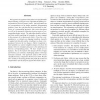Free Online Productivity Tools
i2Speak
i2Symbol
i2OCR
iTex2Img
iWeb2Print
iWeb2Shot
i2Type
iPdf2Split
iPdf2Merge
i2Bopomofo
i2Arabic
i2Style
i2Image
i2PDF
iLatex2Rtf
Sci2ools
116
Voted
CVPR
2005
IEEE
2005
IEEE
Shape Matching and Object Recognition Using Low Distortion Correspondences
We approach recognition in the framework of deformable shape matching, relying on a new algorithm for finding correspondences between feature points. This algorithm sets up correspondence as an integer quadratic programming problem, where the cost function has terms based on similarity of corresponding geometric blur point descriptors as well as the geometric distortion between pairs of corresponding feature points. The algorithm handles outliers, and thus enables matching of exemplars to query images in the presence of occlusion and clutter. Given the correspondences, we estimate an aligning transform, typically a regularized thin plate spline, resulting in a dense correspondence between the two shapes. Object recognition is then handled in a nearest neighbor framework where the distance between exemplar and query is the matching cost between corresponding points. We show results on two datasets. One is the Caltech 101 dataset (Fei-Fei, Fergus and Perona), an extremely challenging da...
Algorithm Handles Outliers | Caltech 101 Dataset | Computer Vision | CVPR 2005 | Feature Points | Geometric Blur Point | Nearest Neighbor Framework |
Related Content
| Added | 12 Oct 2009 |
| Updated | 12 Oct 2009 |
| Type | Conference |
| Year | 2005 |
| Where | CVPR |
| Authors | Alexander C. Berg, Tamara L. Berg, Jitendra Malik |
Comments (0)

